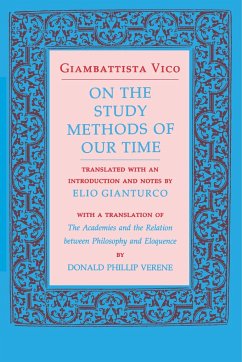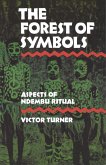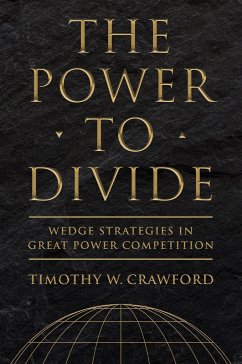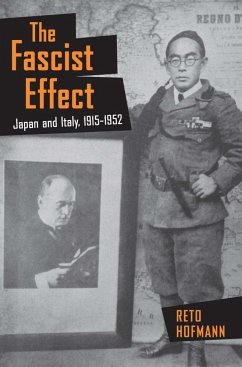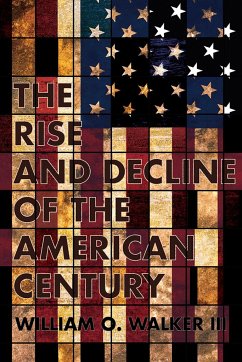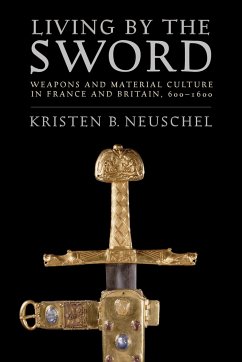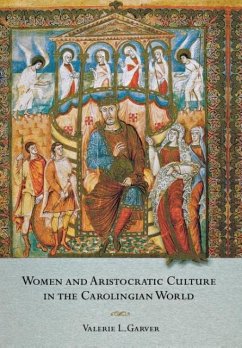Giambattista Vico
On the Study Methods of Our Time
Übersetzer: Verene, Donald Phillip; Gianturco, Elio
Giambattista Vico
On the Study Methods of Our Time
Übersetzer: Verene, Donald Phillip; Gianturco, Elio
- Broschiertes Buch
- Merkliste
- Auf die Merkliste
- Bewerten Bewerten
- Teilen
- Produkt teilen
- Produkterinnerung
- Produkterinnerung
An important contribution to the development of the scientism-versus-humanism debate over the comparative merits of classical and modern culture, this book lays out Vico's powerful arguments against the compartmentalization of knowledge.
Andere Kunden interessierten sich auch für
![The Forest of Symbols The Forest of Symbols]() Victor TurnerThe Forest of Symbols37,99 €
Victor TurnerThe Forest of Symbols37,99 €![Saved at the Seawall Saved at the Seawall]() Jessica DuLongSaved at the Seawall17,99 €
Jessica DuLongSaved at the Seawall17,99 €![The Power to Divide The Power to Divide]() Timothy W. CrawfordThe Power to Divide50,99 €
Timothy W. CrawfordThe Power to Divide50,99 €![The Fascist Effect The Fascist Effect]() Reto HofmannThe Fascist Effect30,99 €
Reto HofmannThe Fascist Effect30,99 €![The Rise and Decline of the American Century The Rise and Decline of the American Century]() Walker, William O., IIIThe Rise and Decline of the American Century59,99 €
Walker, William O., IIIThe Rise and Decline of the American Century59,99 €![Living by the Sword Living by the Sword]() Kristen Brooke NeuschelLiving by the Sword88,99 €
Kristen Brooke NeuschelLiving by the Sword88,99 €![Women and Aristocratic Culture in the Carolingian World Women and Aristocratic Culture in the Carolingian World]() Valerie GarverWomen and Aristocratic Culture in the Carolingian World53,99 €
Valerie GarverWomen and Aristocratic Culture in the Carolingian World53,99 €-
-
-
An important contribution to the development of the scientism-versus-humanism debate over the comparative merits of classical and modern culture, this book lays out Vico's powerful arguments against the compartmentalization of knowledge.
Hinweis: Dieser Artikel kann nur an eine deutsche Lieferadresse ausgeliefert werden.
Hinweis: Dieser Artikel kann nur an eine deutsche Lieferadresse ausgeliefert werden.
Produktdetails
- Produktdetails
- Verlag: Cornell University Press
- Seitenzahl: 144
- Erscheinungstermin: 23. Oktober 1990
- Englisch
- Abmessung: 210mm x 141mm x 13mm
- Gewicht: 188g
- ISBN-13: 9780801497780
- ISBN-10: 0801497787
- Artikelnr.: 21157432
- Herstellerkennzeichnung
- Libri GmbH
- Europaallee 1
- 36244 Bad Hersfeld
- gpsr@libri.de
- Verlag: Cornell University Press
- Seitenzahl: 144
- Erscheinungstermin: 23. Oktober 1990
- Englisch
- Abmessung: 210mm x 141mm x 13mm
- Gewicht: 188g
- ISBN-13: 9780801497780
- ISBN-10: 0801497787
- Artikelnr.: 21157432
- Herstellerkennzeichnung
- Libri GmbH
- Europaallee 1
- 36244 Bad Hersfeld
- gpsr@libri.de
Giambattista Vico. translated by Elio Gianturco and Donald Phillip Verene
Preface by Donald Phillip Verene
Translator's Introduction by Elio GianturcoChronology of Vico's Principal
Writings
Note on the TextON THE STUDY METHODS OF OUR TIME
I. Subject of the present discourse: the comparison, not of the various
branches of learning, but of the study methods of our time and of
antiquity. What factors make up every method of study? Distribution of the
topics to be discussed, new instruments of the sciences. New aids to
studies. Which is, today, the aim of our studies?II. Advantages of our
study methods that derive from the instruments used by modern sciences.
Advantages of philosophical criticism. Analysis. Introduction of the
geometrical method into physics; of chemistry into medicine. Pharmaceutical
chemistry. The introduction of chemistry into physics, and of mechanics
into medicine. The microscope. The telescope. The mariner's compass.
Introduction of modern geometry and physics into mechanics. Advantages
accruing to us from the use of new devices: reduction to theoretical
precepts of matters pertaining to human discretion in the conduct of life.
Masterpieces of art. Printing. Universities. Advantages. deriving from the
aim we have in view in our studiesIII. Drawbacks of modern criticism.
Criticism injurious to prudence. Criticism an obstacle to eloquence: it
hinders the arts, which thrive on imagination, memory, or both. How the
ancients obviated the drawbacks of modern criticism. Modern neglect of
topics, i.e., the art of forms of arguments employed in probable reasoning,
to the benefit of criticism. Drawbacks of this neglect. How the
disadvantages inherent in philosophical criticism may be avoided.IV.
Drawbacks caused by the introduction of the geometrical method into
physics. It kills the desire to explore nature further. How we can study
physics as philosophers, namely, as Christian philosophers. The use of the
geometrical method impairs the faculty to express oneself tastefullv and
with acuteness. It forms an obstacle to free and ample utterance. It
generates a sluggish diction, to be avoided as much as possible in
eloquence. How its drawbacks may be obviated.V. Analysis. It may be useless
to mechanics. How the disadvantages of analysis can be avoided.VI.
Drawbacks of our modern method of studying and practicing medicine. How to
remove them.VII. Disadvantages of our modern study methods in the fields of
ethics, civil doctrine, and eloquence, from the viewpoint of the purpose at
which we aim. Civil doctrine. Eloquence. Civil doctrine and eloquence
again. How the drawbacks of our study methods may be remedied in regard to
the guiding principles of the conduct of life, and in the domain of
eloquence.VIII. Poetry. Under what conditions the modern critical procedure
is useful to poetry. Suitability of the geometrical method to poetry.
"Ideal" or "universal" truth is the proper guiding principle of poetry.
Study of modern physics is conducive to poetry.IX. Christian TheologyX.
Disadvantages of preceptive handbooks framing rules on matters that pertain
to the practical conduct of life. How to eliminate these disadvantages.XI.
The practice and study of law. Greek jurisprudence. Roman jurisprudence.
Jurisprudence of the free Roman republic. Jurisprudence under the Emperors,
prior to Hadrian. Jurisp1-udence under Hadrian. Under Constantine.
Advantages and drawbacks of the study of law. First advantage and first
drawback; second advantage, second drawback; third advantage, third
drawback; fourth advantage, fourth drawback; fifth advantage, fifth
drawback; sixth advantage, sixth drawback tentatively expressed. Advantage
of the jurisprudential method of Accursius and of his disciples. Its
drawbacks: first and second. How disadvantages in the study of law may be
avoided.XII. 70 Masterpieces of art. What drawbacks their existence
produces. How these drawbacks may be got rid of.XIII. Typographical
characters. The disadvantages of printing.' How they may be overcome.XIV.
Universities. Their drawbacks; how they may be remedied.XV.
Conclusion.Appendix: The Academies and the Relation between Philosophy and
Eloquence - Translated by Donald Phillip Verene
Translator's Introduction by Elio GianturcoChronology of Vico's Principal
Writings
Note on the TextON THE STUDY METHODS OF OUR TIME
I. Subject of the present discourse: the comparison, not of the various
branches of learning, but of the study methods of our time and of
antiquity. What factors make up every method of study? Distribution of the
topics to be discussed, new instruments of the sciences. New aids to
studies. Which is, today, the aim of our studies?II. Advantages of our
study methods that derive from the instruments used by modern sciences.
Advantages of philosophical criticism. Analysis. Introduction of the
geometrical method into physics; of chemistry into medicine. Pharmaceutical
chemistry. The introduction of chemistry into physics, and of mechanics
into medicine. The microscope. The telescope. The mariner's compass.
Introduction of modern geometry and physics into mechanics. Advantages
accruing to us from the use of new devices: reduction to theoretical
precepts of matters pertaining to human discretion in the conduct of life.
Masterpieces of art. Printing. Universities. Advantages. deriving from the
aim we have in view in our studiesIII. Drawbacks of modern criticism.
Criticism injurious to prudence. Criticism an obstacle to eloquence: it
hinders the arts, which thrive on imagination, memory, or both. How the
ancients obviated the drawbacks of modern criticism. Modern neglect of
topics, i.e., the art of forms of arguments employed in probable reasoning,
to the benefit of criticism. Drawbacks of this neglect. How the
disadvantages inherent in philosophical criticism may be avoided.IV.
Drawbacks caused by the introduction of the geometrical method into
physics. It kills the desire to explore nature further. How we can study
physics as philosophers, namely, as Christian philosophers. The use of the
geometrical method impairs the faculty to express oneself tastefullv and
with acuteness. It forms an obstacle to free and ample utterance. It
generates a sluggish diction, to be avoided as much as possible in
eloquence. How its drawbacks may be obviated.V. Analysis. It may be useless
to mechanics. How the disadvantages of analysis can be avoided.VI.
Drawbacks of our modern method of studying and practicing medicine. How to
remove them.VII. Disadvantages of our modern study methods in the fields of
ethics, civil doctrine, and eloquence, from the viewpoint of the purpose at
which we aim. Civil doctrine. Eloquence. Civil doctrine and eloquence
again. How the drawbacks of our study methods may be remedied in regard to
the guiding principles of the conduct of life, and in the domain of
eloquence.VIII. Poetry. Under what conditions the modern critical procedure
is useful to poetry. Suitability of the geometrical method to poetry.
"Ideal" or "universal" truth is the proper guiding principle of poetry.
Study of modern physics is conducive to poetry.IX. Christian TheologyX.
Disadvantages of preceptive handbooks framing rules on matters that pertain
to the practical conduct of life. How to eliminate these disadvantages.XI.
The practice and study of law. Greek jurisprudence. Roman jurisprudence.
Jurisprudence of the free Roman republic. Jurisprudence under the Emperors,
prior to Hadrian. Jurisp1-udence under Hadrian. Under Constantine.
Advantages and drawbacks of the study of law. First advantage and first
drawback; second advantage, second drawback; third advantage, third
drawback; fourth advantage, fourth drawback; fifth advantage, fifth
drawback; sixth advantage, sixth drawback tentatively expressed. Advantage
of the jurisprudential method of Accursius and of his disciples. Its
drawbacks: first and second. How disadvantages in the study of law may be
avoided.XII. 70 Masterpieces of art. What drawbacks their existence
produces. How these drawbacks may be got rid of.XIII. Typographical
characters. The disadvantages of printing.' How they may be overcome.XIV.
Universities. Their drawbacks; how they may be remedied.XV.
Conclusion.Appendix: The Academies and the Relation between Philosophy and
Eloquence - Translated by Donald Phillip Verene
Preface by Donald Phillip Verene
Translator's Introduction by Elio GianturcoChronology of Vico's Principal
Writings
Note on the TextON THE STUDY METHODS OF OUR TIME
I. Subject of the present discourse: the comparison, not of the various
branches of learning, but of the study methods of our time and of
antiquity. What factors make up every method of study? Distribution of the
topics to be discussed, new instruments of the sciences. New aids to
studies. Which is, today, the aim of our studies?II. Advantages of our
study methods that derive from the instruments used by modern sciences.
Advantages of philosophical criticism. Analysis. Introduction of the
geometrical method into physics; of chemistry into medicine. Pharmaceutical
chemistry. The introduction of chemistry into physics, and of mechanics
into medicine. The microscope. The telescope. The mariner's compass.
Introduction of modern geometry and physics into mechanics. Advantages
accruing to us from the use of new devices: reduction to theoretical
precepts of matters pertaining to human discretion in the conduct of life.
Masterpieces of art. Printing. Universities. Advantages. deriving from the
aim we have in view in our studiesIII. Drawbacks of modern criticism.
Criticism injurious to prudence. Criticism an obstacle to eloquence: it
hinders the arts, which thrive on imagination, memory, or both. How the
ancients obviated the drawbacks of modern criticism. Modern neglect of
topics, i.e., the art of forms of arguments employed in probable reasoning,
to the benefit of criticism. Drawbacks of this neglect. How the
disadvantages inherent in philosophical criticism may be avoided.IV.
Drawbacks caused by the introduction of the geometrical method into
physics. It kills the desire to explore nature further. How we can study
physics as philosophers, namely, as Christian philosophers. The use of the
geometrical method impairs the faculty to express oneself tastefullv and
with acuteness. It forms an obstacle to free and ample utterance. It
generates a sluggish diction, to be avoided as much as possible in
eloquence. How its drawbacks may be obviated.V. Analysis. It may be useless
to mechanics. How the disadvantages of analysis can be avoided.VI.
Drawbacks of our modern method of studying and practicing medicine. How to
remove them.VII. Disadvantages of our modern study methods in the fields of
ethics, civil doctrine, and eloquence, from the viewpoint of the purpose at
which we aim. Civil doctrine. Eloquence. Civil doctrine and eloquence
again. How the drawbacks of our study methods may be remedied in regard to
the guiding principles of the conduct of life, and in the domain of
eloquence.VIII. Poetry. Under what conditions the modern critical procedure
is useful to poetry. Suitability of the geometrical method to poetry.
"Ideal" or "universal" truth is the proper guiding principle of poetry.
Study of modern physics is conducive to poetry.IX. Christian TheologyX.
Disadvantages of preceptive handbooks framing rules on matters that pertain
to the practical conduct of life. How to eliminate these disadvantages.XI.
The practice and study of law. Greek jurisprudence. Roman jurisprudence.
Jurisprudence of the free Roman republic. Jurisprudence under the Emperors,
prior to Hadrian. Jurisp1-udence under Hadrian. Under Constantine.
Advantages and drawbacks of the study of law. First advantage and first
drawback; second advantage, second drawback; third advantage, third
drawback; fourth advantage, fourth drawback; fifth advantage, fifth
drawback; sixth advantage, sixth drawback tentatively expressed. Advantage
of the jurisprudential method of Accursius and of his disciples. Its
drawbacks: first and second. How disadvantages in the study of law may be
avoided.XII. 70 Masterpieces of art. What drawbacks their existence
produces. How these drawbacks may be got rid of.XIII. Typographical
characters. The disadvantages of printing.' How they may be overcome.XIV.
Universities. Their drawbacks; how they may be remedied.XV.
Conclusion.Appendix: The Academies and the Relation between Philosophy and
Eloquence - Translated by Donald Phillip Verene
Translator's Introduction by Elio GianturcoChronology of Vico's Principal
Writings
Note on the TextON THE STUDY METHODS OF OUR TIME
I. Subject of the present discourse: the comparison, not of the various
branches of learning, but of the study methods of our time and of
antiquity. What factors make up every method of study? Distribution of the
topics to be discussed, new instruments of the sciences. New aids to
studies. Which is, today, the aim of our studies?II. Advantages of our
study methods that derive from the instruments used by modern sciences.
Advantages of philosophical criticism. Analysis. Introduction of the
geometrical method into physics; of chemistry into medicine. Pharmaceutical
chemistry. The introduction of chemistry into physics, and of mechanics
into medicine. The microscope. The telescope. The mariner's compass.
Introduction of modern geometry and physics into mechanics. Advantages
accruing to us from the use of new devices: reduction to theoretical
precepts of matters pertaining to human discretion in the conduct of life.
Masterpieces of art. Printing. Universities. Advantages. deriving from the
aim we have in view in our studiesIII. Drawbacks of modern criticism.
Criticism injurious to prudence. Criticism an obstacle to eloquence: it
hinders the arts, which thrive on imagination, memory, or both. How the
ancients obviated the drawbacks of modern criticism. Modern neglect of
topics, i.e., the art of forms of arguments employed in probable reasoning,
to the benefit of criticism. Drawbacks of this neglect. How the
disadvantages inherent in philosophical criticism may be avoided.IV.
Drawbacks caused by the introduction of the geometrical method into
physics. It kills the desire to explore nature further. How we can study
physics as philosophers, namely, as Christian philosophers. The use of the
geometrical method impairs the faculty to express oneself tastefullv and
with acuteness. It forms an obstacle to free and ample utterance. It
generates a sluggish diction, to be avoided as much as possible in
eloquence. How its drawbacks may be obviated.V. Analysis. It may be useless
to mechanics. How the disadvantages of analysis can be avoided.VI.
Drawbacks of our modern method of studying and practicing medicine. How to
remove them.VII. Disadvantages of our modern study methods in the fields of
ethics, civil doctrine, and eloquence, from the viewpoint of the purpose at
which we aim. Civil doctrine. Eloquence. Civil doctrine and eloquence
again. How the drawbacks of our study methods may be remedied in regard to
the guiding principles of the conduct of life, and in the domain of
eloquence.VIII. Poetry. Under what conditions the modern critical procedure
is useful to poetry. Suitability of the geometrical method to poetry.
"Ideal" or "universal" truth is the proper guiding principle of poetry.
Study of modern physics is conducive to poetry.IX. Christian TheologyX.
Disadvantages of preceptive handbooks framing rules on matters that pertain
to the practical conduct of life. How to eliminate these disadvantages.XI.
The practice and study of law. Greek jurisprudence. Roman jurisprudence.
Jurisprudence of the free Roman republic. Jurisprudence under the Emperors,
prior to Hadrian. Jurisp1-udence under Hadrian. Under Constantine.
Advantages and drawbacks of the study of law. First advantage and first
drawback; second advantage, second drawback; third advantage, third
drawback; fourth advantage, fourth drawback; fifth advantage, fifth
drawback; sixth advantage, sixth drawback tentatively expressed. Advantage
of the jurisprudential method of Accursius and of his disciples. Its
drawbacks: first and second. How disadvantages in the study of law may be
avoided.XII. 70 Masterpieces of art. What drawbacks their existence
produces. How these drawbacks may be got rid of.XIII. Typographical
characters. The disadvantages of printing.' How they may be overcome.XIV.
Universities. Their drawbacks; how they may be remedied.XV.
Conclusion.Appendix: The Academies and the Relation between Philosophy and
Eloquence - Translated by Donald Phillip Verene

